-
Featured News
The MC5: A Eulogy
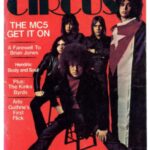 By Doug Sheppard
And then there were none. Five equals zero. The morning of May 9, 2024, the last surviving member of the MC5, drummer Dennis Thompson, died while recovering from a heart attack—
By Doug Sheppard
And then there were none. Five equals zero. The morning of May 9, 2024, the last surviving member of the MC5, drummer Dennis Thompson, died while recovering from a heart attack— -
Featured Articles
The Beatles: Their Hollywood and Los Angeles Connection
 By Harvey Kubernik
JUST RELEASED are two new installments of the Beatles’ recorded history, revised editions of two compilation albums often seen as the definitive introduction to their work.
Or
By Harvey Kubernik
JUST RELEASED are two new installments of the Beatles’ recorded history, revised editions of two compilation albums often seen as the definitive introduction to their work.
Or -
UNO MUNDO (It Came From East Los Angeles)
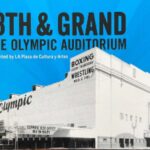
By Harvey Kubernik
Dedicated to Mamie Van Doren Con Art Aragon
This spring and summer at select movie theaters and on cable television’s Spectrum SportsNet, filmmaker Stephen DeBro in his sports and music documentary 18th & Grand: The Olympic Auditorium, tells the story of Los Angeles through the distinctive voices of boxers, wrestlers, roller derby skaters and rock musicians who performed at the Olympic Auditorium. The venue opened in 1925.
In 1951, rhythm & blues concerts were held on the premises. During the 1969-1970 period, Little Richard, Frank Zappa, Mountain, Jack Bruce and Ten Years After were on the marquee. In the eighties and nineties, Public Image Ltd debuted there, and soon afterwards, monthly concerts were promoted by Gary Tovar and Goldenvoice Productions headlining Dead Kennedys, the Dickies, the Circle Jerks, Bad Religion, Suicidal Tendencies, and X. Music videos for Bon Jovi, Kiss, Air Supply, Janet Jackson, and Rage Against the Machine were produced in the landmark location at the corner of 18th Street and Grand Avenue, just south of the Santa Monica Freeway in downtown L.A.
“From the beginning the Olympic was an extension of Hollywood’s back lot,” underscores DeBro. “So many great films were shot at the Olympic, starting with Buster Keaton’s Battling Butler, The Three Stooges Punch Drunks, The Manchurian Candidate, Raging Bull, the Rocky series, Million Dollar Baby, The Turning Point, Requiem for a Heavyweight, The Sting II, and in 2003, Charlie’s Angels: Full Throttle. There were hundreds of TV shows and commercials.”
It’s now the Korean-American Glory Church of Jesus Christ.
The 18th & Grand: The Olympic Auditorium soundtrack is by War, Shuggie Otis, Charles Wright & the Watts 103rd Street Band, Queens of the Stone Age, Dead Kennedys, the Weirdos, Cannibal & the Headhunters, Quetzal and Jungle Fire (Albert Lopez).
DeBro, author and music/culture historian, Gene Aguilera, along with LA Plaza de Cultura’s Karen Crews Hendon and Esperanza Sanchez, are serving as curators of the museum’s forthcoming August 11, 2023-May 12, 2024, 18th & Grand: The Olympic Auditorium exhibition recounts the 80-year history (1925-2005) of the Olympic Auditorium, the home for visceral entertainment in Los Angeles with artifacts from all facets of the venue’s storied history. The exhibit will be held at La Plaza de Cultura Y Artes Museum, 501 N. Main Street, Los Angeles, California 90012.
18th & Grand: The Olympic Auditorium reminds us about nearby East Los Angeles and adjacent Boyle Heights, east of the Los Angeles River. These two Los Angeles’ Chicano/Mexican-American communities gave us Top Forty music hitmakers, Verve Records’ founder Norman Granz, record producers and songwriters Herb Alpert, Lou Adler, H.B. Barnum, Mike Stoller, as well as musician/deejay Lionel “Chico” Sesma, Black Eyed Peas’ will.i.am, and Gene Aguilera.
Spirit: New Book and An Appreciation
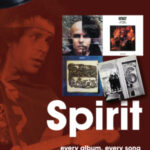
By Harvey Kubernik
There’s a newly published book on the cult American band Spirit by Rev. Keith A Gordon, now available from SonicBond Publishing, SPIRIT On Track. It’s a journey through every album and very song. The book is way more than a mere album guide. Gordon’s book recounts 30 years of the trailblazing artistry of Spirit. They remain an influence on UK music groups. Spirit is the band seldom cited in classic rock discussions.
The original group members were drummer Ed Cassidy, guitarist Randy California, Jay Ferguson, vocals, Mark Andes on bass and keyboardist John Locke. Spirit was discovered by record producer Lou Adler, who saw them gig at the Ash Grove club on Melrose Avenue in Los Angeles, and had them audition for him on Sunset Boulevard at the Whisky A Go Go. He inked them to his Ode Records label, and produced their first three albums. Adler and Spirit would appear in the acclaimed film, Model Shop, directed by Jacques Demy.
Esteemed journalist Richard Williams hailed Spirit in the February 7, 1970 issue of the now defunct Melody Maker. “Spirit is one of those fine American groups which came to light following the Indian summer of 1967, and which have never really gained the attention their originality and musicianship deserve.”
Spirit’s chart hit single, “I Got a Line on You,” is still programmed by terrestrial and satellite radio stations. On occasion, you can hear their Randy California-penned prophetic ecological lament to the planet, “Nature’s Way,” produced by David Briggs. The tune has been covered by Alice Cooper and Jeff Healey, among others. Mark Andes, the original bassist in Spirit, who subsequently founded the band Firefall, recorded it along with Timothy B. Schmit of the Eagles and John McFee from the Doobie Brothers on their 2010 album, Comet.
Daniel Weizmann (Novelist): It’s amazing how many cats that made their mark on seventies hit radio got their start woodshedding on the Sunset Strip. From Gates to Zevon to California and beyond…these guys were tumbled by the psychedelic machine, they knew the meaning of a hook, and they had one foot in the counterculture, one arm reaching for the pot of gold. That’s why we are still in awe of that whole era stretching through both decades—it was energized by so many contradictions.
In the July 26, 1975 issue of Melody Maker, I interviewed Ed Cassidy.
“The band was definitely ahead of the times in many areas. We were together while working towards a certain goal.”
At 52, Ed Cassidy presents an antithesis from your regular rock and roll drummer/percussionist. His roots are in jazz and he first picked up the sticks in 1939. Over the last 30 years he’s logged time with Gerry Mulligan, Thelonious Monk, Cannonball Adderley and Zoot Sims among others. He played around California in the 50’s and surprisingly, offers a slightly different view of the jazz musician.
“I was always frustrated in jazz. The jazz musician was not for the most part what he was billed as: great liberal entertainer who was into integration, understanding and being fair. Most of the jazz musicians I was exposed to were prejudiced and into the big bucks.”
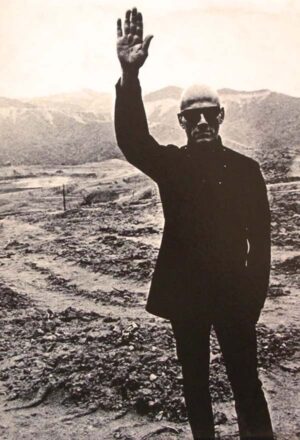
In 1965 the Ash Grove, a local coffee house, featured a group, the Rising Sons, featuring Taj Mahal, Ry Cooder and Cassidy, who displayed their wares rather cheaply.
“I didn’t mind playing for hamburgers. There was an incredible vibe happening and all the groups in the area loved playing there.”
Then Ed met Bernice Wolfe and her son Randy, who was gigging in a group with keyboardist John Locke called the Red Roosters. Subsequent marriage to Bernice and a move to New York followed. Ed inherited a son who was a pretty incredible guitar player. “Randy did a lot of jamming with Hendrix and I was into a jazz trio,” reflects the Topanga Canyon-based musician.
It was Hendrix who gave Randy Wolfe his new name, Randy California.
In 1967 Spirits Rebellious was born.
“We got the name from a Kahlil Gibran book. We then shortened it to Spirit. The concept was mine; a group trying to blend all types of music together. There was no problem with age, I was pretty bizarre in my own way,” Ed laughs. “There wasn’t a generation gap and it was pretty cool. I even played differently than most of the rock drummers; a bastardized version of rock, incorporating my own trip.”
So, the family that played together stayed together – for a while. Their first album Spirit, was a unique blend of jazz, rock, and the avant-garde. Commercially, the first LP had some near misses and it wasn’t until The Family That Plays Together, their second disc, that the group started to get heard on the radio.
“In the first album,” suggests Ed, “there was a lot of jazz. We were exploring new ways of improvisation. Randy and I were keen on that. The thing that was successful about Spirit then, and now, was that we didn’t try to contrive any of the elements that appeared in the music. We weren’t rock and rollers and we weren’t jazz. It just happened. Oh…The band had to be seen to be believed. Our LP’s were pale by comparison.”
Spirit, on stage and on records, also helped circumvent their cultist following and bring in a few more curious lookers and listeners.
“Yeah…It was unique in a way, soft on record and our stage thing was so concrete that more people got into us for that reason. It developed that way as opposed to proper promotion.”
In 1969 I witnessed Spirit blow the Jimi Hendrix Experience off the stage at the Newport ’69 pop festival in Northridge, California. During 1971 I caught their set opening for the Moody Blues at the Fabulous Forum in Inglewood. They were terrific.
Around 1976 I went to a Spirit reunion show at the Santa Monica Civic Auditorium. A dazed Neil Young came out to jam on the encore of Bob Dylan’s “Like a Rolling Stone.” However, his erratic behavior confused Randy, who didn’t recognize Neil, spoiling the event, which really upset John Locke.
Los Angeles native Locke was very kind to me when I first started producing recording sessions and complimented my nascent journalism efforts.
Dr James Cushing: (poet/deejay): I never saw Spirit in concert, so my assessment of them is based 100% on the recorded evidence. But I think that these five guys came up with a convincing musical eclecticism highly characteristic of LA rock in that 1967-70 period, a quality I find lacking in today’s niche-marketed pop. And while I put Twelve Dreams on top, I get real enjoyment from five of their albums.
Spirit: their first album spotlights their hard-to-describe, super-eclectic sound. Elements of jazz (the electric piano solo on “Fresh Garbage”), psychedelia, Latin rhythms, Beatle-esque pop, sitars, Zappa, Hendrix, the through-composed “Taurus” all mix to the point that the debut almost resembles an imaginary Ode Records compilation-sampler album. In this band, the music is the lead feature, not the guitar or the drummer or the charismatic singer. Dig the distorted guitar playing a jazz solo on “Straight Arrow”!
The Family That Plays Together: this is the one that opens with “I Got a Line on You,” a big radio hit in late 1968. No sophomore slump here! Note that the lead vocal is down in the mix. Note also that no other cut sounds remotely like that one. The second cut, for example, swerves toward a soft jazz sound with flute… As with Pepper, the songs segue together, so you get the sense of each LP side being a single statement, and you can’t predict what the next part of any cut will sound like. Their group sound “contains multitudes.” Dig the mysterious ending of “Drunkard.” We like their joyful disregard of genre boundaries!
Clear Spirit: A bit of a simpler blues-rock sound on this one, recorded 1969. “Apple Orchard” has a little bit of Sly’s “Don’t Call Me N*****, Whitey” in the main riff. Then they give us the bouncy pop of “So Little Time to Fly.” One surprise follows another! The category-resistant eclecticism of this band emerges here as their main feature. I suppose helpful comparisons could be with early Traffic, or the Beatles’ white album… “Policeman’s Ball” anticipates rap.
The Twelve Dreams of Dr. Sardonicus: The group’s acknowledged high point, and one of 1970’s most memorable releases, it opens with acoustic flourishes that recall Love’s Forever Changes and has interesting similarities with that album. Producer David Briggs gave The Twelve Dreams of Dr. Sardonicus a fuller, crisper sound than the earlier LPs, with more prominent vocals, and the songs have legs, esp. “Nature’s Way,” the band’s strongest melody since “I Got a Line on You.” And the arrangements… dig the vibes on top of the backwards cymbals on “Love Has Found a Way”! And why haven’t more bands done covers of “Mr. Skin”? (Who plays sax on that track?)
Kapt. Kopter and the (Fabulous) Twirly Birds: Randy California’s 1972 solo album is a loud rock power-trio session ripe for rediscovery. Randy was Hendrix’s second guitarist in Jimmy James and the Blue Flames for three months in 1966, and “Downer,” which starts like a Jimi outtake, gives a hint of what that mad magic might have sounded like. Jimi’s Flames played mostly covers, and Kapt Kopter takes on tunes by James Brown, Lennon-McCartney, and Paul Simon while remaining very lead-guitar oriented.”
Further kudos and homage to Spirit can be heard today from Morley Bartnoff and the Randy Californians, who just released their very first single “Dog Georgee,” available on all streaming formats.
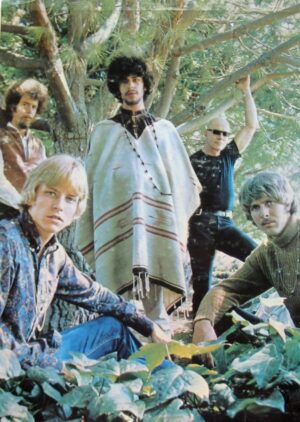
Morley Bartnoff (Keyboardist): Just how significant were/are the first two albums by the band Spirit? Not just to my musical trajectory but to the progressive psychedelic jazz rock expansion of rock and roll music everywhere for everyone all at once?
While the rest of the world seemed to be obsessing about the Haight Ashbury and the Sunset Strip, Topanga Canyon made a massive contribution by formulating the gestation and cosmic birthing of the first two Spirit albums. Randy Wolf California’s Wes Montgomery meets Jimi Hendrix, combined with the pure jazzed dynamics of Randy’s stepfather Ed Cassidy provided the perfect freeform acid-tinged, jazz-rock, inspiring the continuously creative Comping explorations, with real and electric pianos that were parlayed by my favorite all time heart full of jazzy soul keyboardist, John Locke.
The very first time I heard “Mechanical World” coming out of my Las Vegas KENO AM radio station in 1967. I knew that along with Dorothy and Toto we were not in Kansas anymore. That black and white had somehow magically and deliciously turned into an eternally, unique, technicolor mind movie that was hauntingly spooky and evolving into a permanent relationship with multiple musical shapes and textures that were completely unknown until now. Sprinkled with the spice of those creative orchestral arrangements the entire enchilada gave a brand-new meaning to let me turn you on to this absolutely exciting new band that lives in Topanga Canyon!
Once you ponder the variety of styles and the musicality of the first two albums by Spirit which seamlessly interspersed jazzed-up jams with well-rehearsed song cycles, you’ll begin to understand how appealing the first two LPs by the original five members of Spirit was to me and the rest of our psychedelically enhanced community
“I Got a Line on You” was on the FM radio stations which is a song I still cover all the time today but Spirit’s, sophomore, song cycle also had intriguing melodies like “Jewish” as Randy sang in Hebrew. Truly telegraphing that progressive music was being intentionally co-created by these five diversely inventive amazing art jazz rock indie visuals.
I greatly appreciate Clear Spirit and The 12 Dreams of Dr. Sardonicus, however, the monumental impact of their self-titled first album and their equally intriguing follow up, The Family That Plays Together, will forever formulate shape and inspire my continuing focus to play progressive music.”
© Harvey Kubernik, 2023.
HARVEY KUBERNIK is the author of 20 books, including 2009’s Canyon Of Dreams: The Magic And The Music Of Laurel Canyon and 2014’s Turn Up The Radio! Rock, Pop and Roll In Los Angeles 1956-1972. Sterling/Barnes and Noble in 2018 published Harvey and Kenneth Kubernik’s The Story Of The Band: From Big Pink To The Last Waltz. In 2021 they wrote Jimi Hendrix: Voodoo Child for Sterling/Barnes and Noble. Otherworld Cottage Industries in 2020 published Harvey’s Docs That Rock, Music That Matters.
Kubernik’s writings are in several book anthologies, most notably, The Rolling Stone Book Of The Beats and Drinking With Bukowski. Harvey wrote the liner notes to the CD re-releases of Carole King’s Tapestry, The Essential Carole King, Allen Ginsberg’s Kaddish, Elvis Presley The ’68 Comeback Special, The Ramones’ End of the Century and Big Brother & the Holding Company Captured Live at The Monterey International Pop Festival).
The Harder They Come: 50th Anniversary and Musical Adaptation
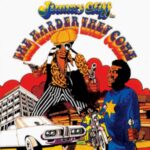
By Harvey Kubernik
During 1969, Jimmy Cliff’s “Wonderful World, Beautiful People,” “The Israelites” from Desmond Dekker & the Aces, and a hit single from Johnny Nash, “Hold Me Tight,” earlier exposed reggae to radio airplay in Southern California and several Stateside areas. In the summer of 1972, Nash’s “I Can See Clearly” reached number one on the US Billboard and Cash Box charts.
Island Records’ Chris Blackwell, the visionary A&R man and label owner had signed a handful of reggae artists to bring the probing bass propelled messages from Jamaica to a global audience.
In June 1972, the Jamaican crime drama film The Harder they Come, directed by Perry Henzell and co-written by Trevor D. Rhone, starring Jimmy Cliff premiered in Jamaica.
It tells the story of Ivanhoe Martin, (Jimmy Cliff), a young singer who arrives in Kingston, Jamaica, desperate and eager to become a star in that country. He falls in love with a woman and quickly signs a record deal with a powerful music mogul, and soon learns that the record game is rigged. Angered and confident, Ivan becomes increasingly defiant, and finds himself in a battle that threatens not only his life, but the very fabric of Jamaican society.
The well-received film yielded a reggae soundtrack courtesy of the Island company that further positioned these intriguing, enticing sounds to the world.
A publicist, Michael Ochs, who I knew from his 1969-1972 PR department tenure at Columbia Records in Hollywood, was hired by record producer and talent scout Denny Cordell to publicize the soundtrack of The Harder They Come. Michael wrote for Melody Maker in 1972. We both attended a handful of regional June 1972 concerts by the Rolling Stones after the release of Exile on Main Street.
Ochs mailed a copy of The Harder They Come LP, a press kit and a mango fruit, all contained in a burlap bag that arrived to my college dormitory single room at Zura Hall at San Diego State University. The package’s mailing sticker came from Mango/Capitol Records.
In 1972 I had only written a couple of record reviews at the time for The Hollywood Press. I suggested a review of the album in the school newspaper, The Daily Aztec, and was rejected.
The hypnotic reggae pulse on my record player was so captivating. I needed to see this movie.
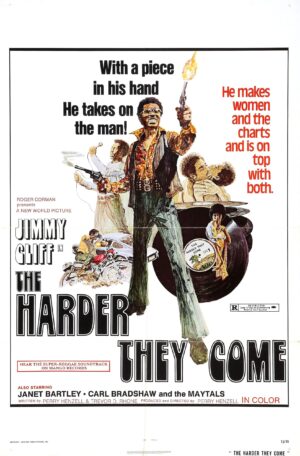
In November 1972 I caught the debut of The Harder They Come in Hollywood at Grauman’s Chinese Theater, where it screened as part of Filmex, the Los Angeles International Film Exposition. The place was packed and the crowd loved it.
Independent producer/director/film guru Roger Corman secured domestic distribution of the movie via his company New World Pictures.
The landscape and musical climate of the United States was altered by the December 26th -December 31, 1972 premiere of The Harder They Come at the Nu-Art Theater in Westwood, California.
In February 1973 it was booked in New York City, and gained a small cult gathering at nationwide midnight movie showings in select locals. However, it was the movie’s soundtrack that quickly generated pivotal FM radio spins that spring of ’73.
The Harder They Come soundtrack was recorded at Dynamic Sounds in Kingston, Jamaica. It housed selections from Jimmy Cliff, the Maytals, the Slickers, Scotty, Desmond Dekker, and the Melodians.
“Denny Cordell called me in 1972 and wanted me to do the publicity for the soundtrack,” recalled author and archivist Michael Ochs to me in a July 2021 interview.
“I saw it at Filmex, and loved the soundtrack album. I fell in love with reggae. Denny and Leon Russell were partners in Shelter Records and Leon spent a lot of money on a remote recording truck. I was at the Wailers taping in October 1973 at the Capitol studio which was fun. It was like a big rehearsal leading to a real performance.
“The rock press loved the movie and the soundtrack. It was too unique for AM and FM radio. Black radio programmers were not receptive at all. At the time there was a dearth of originality. When this happens, the media tend to go to roots music, like blues. Reggae was the light at the end of the tunnel. It was important to promote it. At that time, I wasn’t sure if Toots [Hibbert] & the Maytals or Bob Marley was going to be the leader of the movement.
“Denny then hired me for the Shelter label. He agreed to pay a salary, an office and a secretary. J.J. Cale and Phoebe Snow were two of the artists I worked with.
“Denny agreed to fly me down to Kingston if I could get a story in Rolling Stone so I called my friend Michael Thomas and he sold it to Stone. So, Rolling Stone paid for Michael to come from London to do the story. Chris Blackwell loaned us one of his houses for us to stay in—me, Michael and photographer Arthur Gorson.
“Robert Christgau didn’t stay there but came at the same time to do a five-part story for Newsday, a Long Island paper. Michael and Arthur went into Trench town to interview Marley but they were the only two that were allowed in. For the rest of the time, we were down there, different reggae artists, including Toots were sent to the house to talk to Michael for the story.”
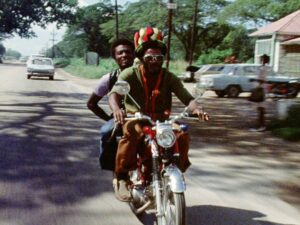
##
Roger Steffens is the author of seven books about the Wailers, Bob Marley, and the history of reggae. His award-winning Reggae Beat radio program was syndicated to 130 stations world-wide. Since 1984 he has lectured internationally with a multi-media presentation called The Life of Bob Marley. He is the co-founder of The Beat magazine and served as founding chairman of the Reggae Grammy Committee for 27 years. Roger is the former national promotions director for reggae and African music of Island Records.
I asked Steffens about The Harder They Come.
“Back in early summer of 1973 an Australian gonzo journalist named Michael Thomas wrote an extraordinary article in Rolling Stone outlining the history of Jamaican music from the ska and rock steady eras into the emerging internationalization of reggae, particularly through the success of The Harder They Come film. It featured some of the major Jamaican stars of the moment, including the movie’s lead Jimmy Cliff and Toots & the Maytals. The mesmerizing tale was based on the true story of a ’40s gunman named Rhygin (“raging”) who killed cops and became a folk hero.
“The film became a lynchpin of a newly popular trend of Midnight Movies from coast to coast. In Boston it played in Harvard Square for eight years, and when Jimmy was playing in that city, he was known to enter the theater unannounced and jump on stage pretending to hold six guns, mimicking a scene in which he is photographed in his gun-tottin’ bad boy pose, in a photo studio, much to the audience’s astonishment.
“The day after I read the article, I saw the movie in a tiny northside theater in Berkeley, holding about 40 seats. When the scene of a midnight chalice-smoking scene came on screen, everyone in the theater lit up and there was so much smoke in the room you couldn’t see the screen! On the way home I bought the soundtrack, which led me to seek out recordings by each of its contributors.”
##
The world premiere of The Harder They Come, Suzan-Lori Parks’ musical adaptation of the 1972 film is scheduled to be staged at New York’s Public Theater during February 16th-March 26th 2023 in the Newman Theater.
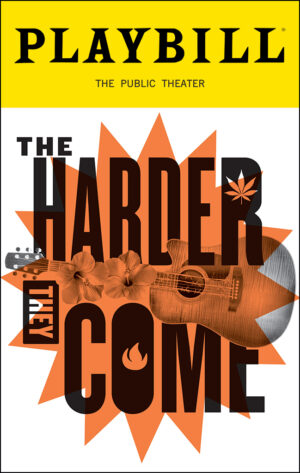
The show includes “You Can Get It If You Really Want It” and “Many Rivers to Cross” by Grammy Award winner Jimmy Cliff, based upon the film produced and directed by Perry Henzell and co-written with Trevor Rhone. Music Supervision, Orchestrations, and Arrangements by Kenny Seymour, choreography by Edgar Godineaux, co-directed by Sergio Trujillo, directed by Tony Taccone. Parks is a Pulitzer Prize-winning playwright and the Public’s Writer-in-Residence.
In 2005, The Harder They Come had been adapted into a stage musical by the Royal Stratford East and UK Arts International in the UK where Henzell oversaw the script.
##
On the day Duke Ellington died, May 24, 1974, I encountered Johnny Nash in the lobby of Columbia Records on Sunset Blvd in Hollywood. We had a brief chat.
I acknowledged his seminal 1967-1972 work with the Wailers, where he developed Marley’s nascent songwriting abilities on his JAD record label. Johnny smiled when I mentioned his co-writing of a song, “Some of You Love,” with record producer Phil Spector in 1961 when he was inked to ABC-Paramount Records. Spector first met Nash, and songwriter Tommy Boyce, during their Army physical examinations.
As Johnny and I left the elevator ride, I wished I would have reminded myself to tell Nash how much I loved his song “What Kind of Love Is This?” Joey Dee & the Starliters had cut the tune in 1962 for the Columbia studio picture Two Tickets to Paris.
I eventually witnessed eight Bob Marley & the Wailers concerts during 1975-1979. First time was July 13, 1975 at the Roxy Theater in West Hollywood.
I interviewed the group in 1976 for Melody Maker. Our conversation was held in such a smoke-filled room in West Hollywood at the Island Records office in California on Sunset Blvd I forgot to turn the tape machine on!
John Lennon and Yoko Ono attended a Wailers’ May 16, 1976 Roxy show. While waiting for their car to arrive in the parking lot of the adjacent Rainbow Bar & Grill, I thanked John for introducing me to reggae and blue beat music that he touted in music publications and radio interviews.
On July 22, 1978 I went to see the Wailers at The Starlight Bowl Ampitheatre in Burbank. A few reporters were given tickets and all access backstage passes. At the time press coverage in the US was important for the Wailers and Marley’s mission.
I watched the concert from the wings standing the whole evening with Mick Jagger, holding daughter Jade in his arms. Mick still happily managed to pass some ganja to our circle that included Peter Tosh, the opening act the next day for the Rolling Stones at Anaheim Stadium.
Before the awe-inspiring evening concluded, a sweaty Bob Marley ran to our side of the venue, brushing up against me on his way to talk to Peter, who then joined him for a surprise appearance during “Get Up, Stand Up.”
Tosh later told Roger Steffens, “Mi slap Bob’s hand and him say, ‘Bwoi, de Pope feel dat one.”’
Three days later the Pope died.
##
Bob Marley has been inducted into the Rock and Roll Hall of Fame (1994) and ASCAP Songwriters Hall of Fame (2010).
The first US residency for the multi-room Bob Marley One Love Experience will be held in Southern California at LA’s Ovation Hollywood – from January 27-April 23, 2023.
Visitors will see Marley’s entire Rock & Roll Hall of Fame archive at the exhibition, alongside previously unseen photos, rare memorabilia, concert videos, guitars, lyric sheets, sneakers, a Marley-branded jukebox, and Marley-themed artwork. There will be a silent disco with headphones at the Soul Shakedown studio, where fans can dance along to Marley’s music. One area celebrates the Marley family legacy and philanthropy.
The event is created in partnership with the Marley Family and Terrapin Station Entertainment. The exhibition’s director and producer, Jonathan Shank, added: “The Bob Marley One Love Experience has already created so many positive vibrations for fans in London and Toronto, and it’s an honor to continue to have the opportunity to curate and produce the exhibit right in the heart of Hollywood.”
Tickets available on The Bob Marley One Love Experience website.
© Harvey Kubernik 2023
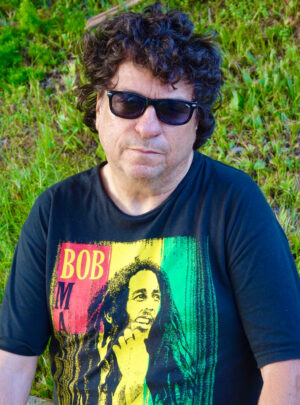
Harvey Kubernik (Photo: Jan Kessel)
Harvey Kubernik is the author of 20 books, including 2009’s Canyon Of Dreams: The Magic And The Music Of Laurel Canyon and 2014’s Turn Up The Radio! Rock, Pop and Roll In Los Angeles 1956-1972. Sterling/Barnes and Noble in 2018 published Harvey and Kenneth Kubernik’s The Story Of The Band: From Big Pink To The Last Waltz. In 2021 they wrote Jimi Hendrix: Voodoo Child for Sterling/Barnes and Noble. Otherworld Cottage Industries in 2020 published Harvey’s Docs That Rock, Music That Matters.
Kubernik’s writings are in several book anthologies, including The Rolling Stone Book Of The Beats and Drinking With Bukowski. Harvey has written liner notes to CD releases of Carole King’s Tapestry, The Essential Carole King, Allen Ginsberg’s Kaddish, Elvis Presley The ’68 Comeback Special, the Ramones’ End of the Century, and Big Brother & the Holding Company Captured Live at The Monterey International Pop Festival.
In 2006, Kubernik was invited to address audiotape preservation held by the Library of Congress in Hollywood.